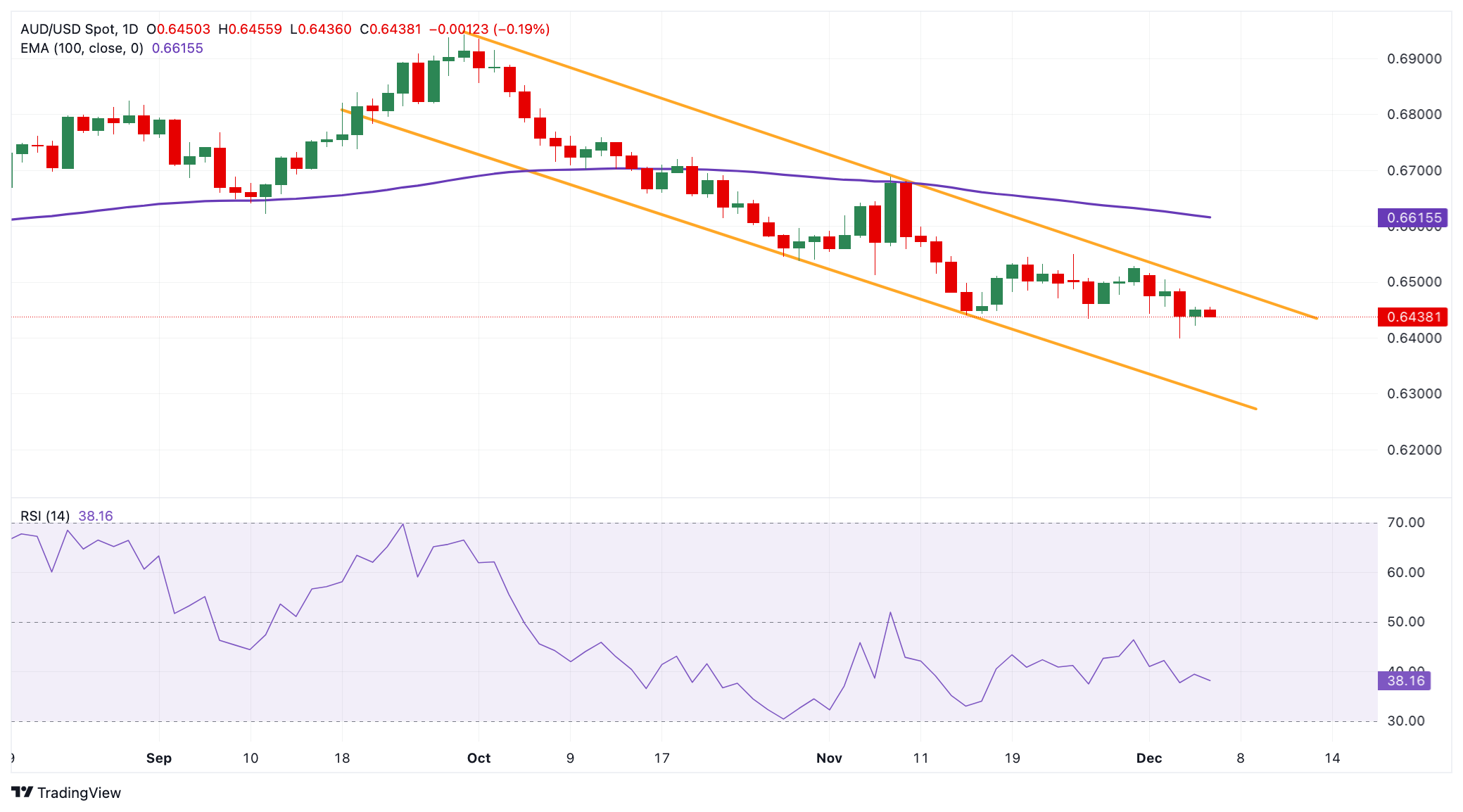- The Australian Dollar attracts some sellers in the Asian session on Friday.
- Disappointing GDP number boosts RBA rate cut bets, weighing on Aussie.
- The US Nonfarm Payrolls report will be in the spotlight on Friday.
The Australian dollar (AUD) gives ground on Friday. Disappointing economic growth could prompt the Reserve Bank of Australia (RBA) to adopt a more dovish tone at next week’s policy meeting, potentially setting the stage for a rate cut in February. This, in turn, puts some selling pressure on the Aussie.
Traders will closely monitor the US November employment report, which includes Non-Farm Payrolls (NFP), Unemployment Rate and Average Hourly Earnings. The US economy is expected to add 200,000 jobs in November after increasing by 12,000 in October. In case of a weaker than estimated result, this could drag the Dollar lower and create a tailwind for the AUD/USD.
Australian Dollar Loses Traction Amid Uncertainties
- A Reuters poll of 44 economists showed the RBA is expected to keep the cash rate unchanged at 4.35% at the next meeting and the RBA is expected to cut the rate by 25 basis points to 4.10% in the second quarter of 2025 (vs. to the first quarter in the November survey).
- Australia’s GDP expanded 0.3% quarter-on-quarter in the three months to September, compared with growth of 0.2% in the second quarter. This reading was below the market consensus of 0.4%.
- Initial claims for jobless benefits in the US increased by 9,000 to 224,000 for the week ending November 29, according to the US Department of Labor (DoL) on Thursday. This reading exceeded initial estimates and was higher than the previous week’s 215,000.
- Continuing claims for unemployment benefits fell by 23,000 to 1.871 million for the week ending November 22.
- Fed Chairman Jerome Powell declared on Wednesday that the US economy is stronger now than the US central bank had expected in September when it began cutting interest rates, which It means that the US central bank can show some restraint in reducing interest rates.
AUD/USD bearish bias remains unchanged in the long term
The Australian Dollar is trading weaker on the day. The AUD/USD pair maintains the bearish vibe on the daily chart as the price is below the 100-day exponential moving average (EMA). The 14-day Relative Strength Index (RSI) is below the 50 midline near 38.85, indicating bearish momentum. This suggests that the path of least resistance is downward.
The potential support level emerges at 0.6300, representing the lower boundary of the downtrend channel and the psychological level. Bearish candles below this level could attract more sellers towards 0.6285, the October 3, 2023 low.
A sustained bullish momentum above the upper boundary of the trend channel at 0.6500 could see a rally towards 0.6615, the 100-day EMA. A decisive break above the mentioned level could expose 0.6687, the November 7 high.
The Australian Dollar FAQs
One of the most important factors for the Australian Dollar (AUD) is the level of interest rates set by the Reserve Bank of Australia (RBA). As Australia is a resource-rich country, another key factor is the price of its largest export, iron ore. The health of the Chinese economy, its largest trading partner, is a factor, as is inflation in Australia, its growth rate and the Balance of Trade. Market sentiment, that is, whether investors bet on riskier assets (risk-on) or seek safe havens (risk-off), is also a factor, with the risk-on being positive for the AUD.
The Reserve Bank of Australia (RBA) influences the Australian Dollar (AUD) by setting the level of interest rates that Australian banks can lend to each other. This influences the level of interest rates in the economy as a whole. The RBA’s main objective is to maintain a stable inflation rate of 2%-3% by adjusting interest rates up or down. Relatively high interest rates compared to other major central banks support the AUD, and the opposite for relatively low ones. The RBA can also use quantitative easing and tightening to influence credit conditions, with the former being negative for the AUD and the latter being positive for the AUD.
China is Australia’s largest trading partner, so the health of the Chinese economy greatly influences the value of the Australian Dollar (AUD). When the Chinese economy is doing well, it buys more raw materials, goods and services from Australia, which increases demand for the AUD and drives up its value. The opposite occurs when the Chinese economy does not grow as fast as expected. Therefore, positive or negative surprises in Chinese growth data usually have a direct impact on the Australian Dollar.
Iron ore is Australia’s largest export, with $118 billion a year according to 2021 data, with China being its main destination. The iron ore price, therefore, may be a driver of the Australian dollar. Typically, if the price of iron ore rises, the AUD also rises as aggregate demand for the currency increases. The opposite occurs when the price of iron ore falls. Higher iron ore prices also tend to result in a higher likelihood of a positive trade balance for Australia, which is also positive for the AUD.
The trade balance, which is the difference between what a country earns from its exports and what it pays for its imports, is another factor that can influence the value of the Australian dollar. If Australia produces highly sought-after exports, its currency will gain value solely from the excess demand created by foreign buyers wanting to purchase its exports versus what it spends on purchasing imports. Therefore, a positive net trade balance strengthens the AUD, with the opposite effect if the trade balance is negative.
Source: Fx Street
I am Joshua Winder, a senior-level journalist and editor at World Stock Market. I specialize in covering news related to the stock market and economic trends. With more than 8 years of experience in this field, I have become an expert in financial reporting.







